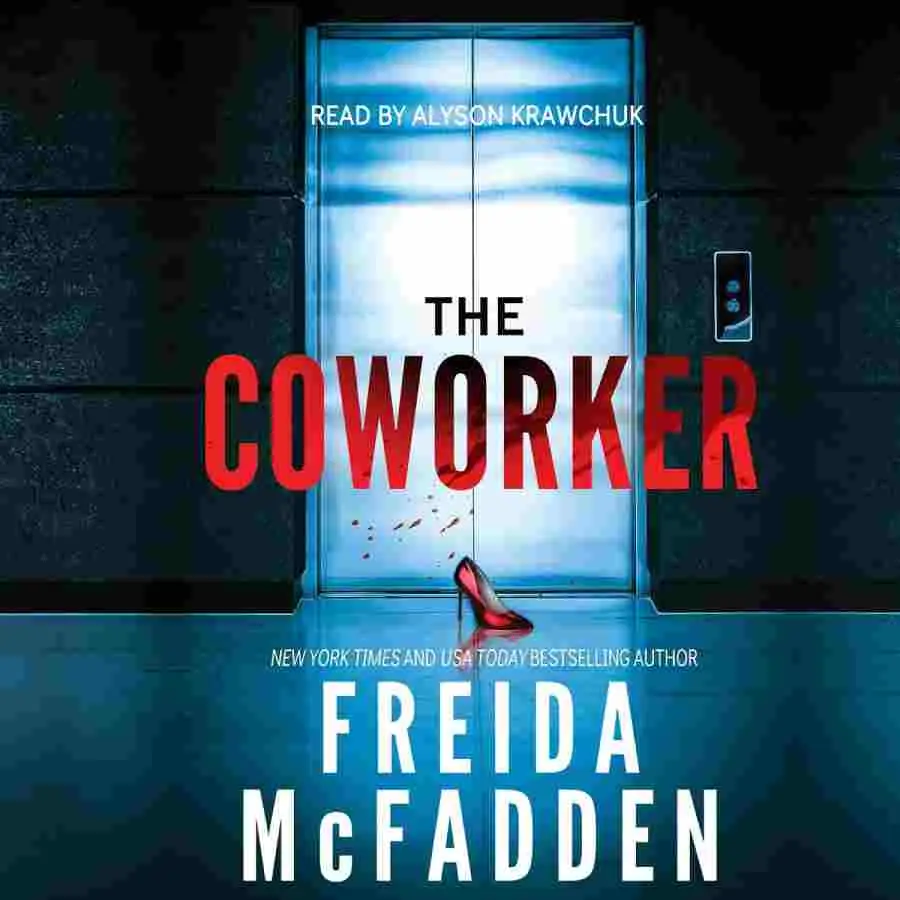

It was one of those late evenings when I got myself down a rabbit hole of thrillers, the type of night when you should have gone to bed but instead find yourself thinking, “Just one more chapter.” Of course, this chapter is always followed by five more, and before you know it, the sun has risen. My hunt for a new novel that may provide the same excitement brought me to Freida McFadden’s The Coworker.
I’ve read more psychological thrillers than I can count, each with its unique blend of tension and intrigue. Some strike the spot, leaving you breathless at the end, while others fade away before the climax. Still, the genre has a particular place in my heart, much like an old trusty buddy who knows how to keep you on your toes. What originally intrigued me to The Coworker was the promise of a tight, office-based drama—a setting that many people are acquainted with but is seldom handled in such a dark, twisted manner.
Freida McFadden is not a new name in the thriller genre, and I have already read her work. Her ability to transform commonplace circumstances into something evil reminded me of another novel I just finished: Local Woman Missing by Mary Kubica. Both works dive into the underbelly of apparently regular lives, revealing truths that are far from ordinary. The contrast is in the location; whereas Kubica’s narrative takes place in a close-knit community, McFadden’s drama takes place in an office, which is frequently associated with regularity and order rather than suspense and murder.
Overview of Plot and Characters
The Coworker revolves on two ladies whose lives are inextricably linked by their employment, Vixed, a nutritional supplement firm. Dawn Schiff, the heroine, defies the stereotype of a starring woman in a thriller. She’s uncomfortable, a bit of a loner, and obsessed with her rituals, particularly her love of turtles. She is always at her desk by 8:45 a.m. precisely, rain or shine, so her unexpected absence one day sends shockwaves across the company.
The second main character is Natalie Farrell, Dawn’s colleague and, in many respects, her polar opposite. Natalie is the office star—beautiful, personable, and the top sales representative at Vixed for the last five years. She’s the kind of person that seems to have it all together, the one everyone else aspires to be or befriends. Natalie and Dawn seem to have nothing in common, other than the fact that they work in the same office, but as the novel progresses, their lives become more entangled.
Natalie is confused when Dawn fails to arrive at work one morning. This bewilderment rapidly turns to alarm when she gets an anonymous and extremely disturbing phone call. The caller hints that Dawn’s absence was not an accident, and when Natalie investigates more, she realizes that Dawn’s life is considerably more complicated—and dangerous—than anybody in the office could have anticipated.
What follows is a gripping investigation into secrets, deception, and the worst aspects of human nature. McFadden expertly weaves the story between Dawn’s and Natalie’s viewpoints, giving readers a better knowledge of each character while keeping the tension high. The dual viewpoint allows for a thorough examination of how two very different individuals may be linked by events beyond their control, culminating in a conclusion that is both startling and fulfilling.
Detailed Plot Summary with Spoilers
The narrative of The Coworker starts with the ordinary—a regular day at Vixed, when people go about their business, some focused on their duties, some less so. Dawn Schiff, on the other hand, never loses concentration. She’s the sort of worker that is never late, always meticulous, and a little mysterious. Her desk reflects her careful temperament, with every thing in its proper place and every document filed appropriately. Dawn is clearly distinct from her colleagues, who see her as an outlier who just does not fit into the corporate atmosphere.
But on this particular day, Dawn’s desk is vacant. For a lady noted for her timeliness and strict attention to routine, her absence is instantly evident. Natalie Farrell, who generally doesn’t pay Dawn any attention beyond polite, surface-level encounters, is now interested and worried. When Natalie gets a call from an unknown number, her curiosity turns to fear. The caller hints that Dawn’s disappearance is due to something considerably more nefarious than a simple absence from work.
As Natalie investigates Dawn’s life, she discovers a number of troubling things. Dawn, who always looked to be on the fringe, was concealing a turbulent history filled with bullying and social isolation. Dawn’s love of turtles, which was originally a unique personality feature, is shown to be a coping strategy, allowing her to escape into a secure environment. Throughout the novel, the turtles, which represent Dawn’s desire for protection and shelter, serve as a heartbreaking metaphor.
The story shifts between the present and the past, offering light on Dawn’s time at Vixed. Dawn, far from being a harmless weirdo, was the victim of subtle but severe workplace bullying. Her colleagues, maybe inadvertently, added to her feelings of estrangement, making her existence at Vixed more unpleasant. Natalie, who originally dismissed Dawn as an odd coworker, comes to grasp the whole picture: Dawn was more than simply unusual; she was severely hurt by the acts of people around her.
The tension in the workplace rises as the inquiry into Dawn’s absence becomes more serious. Natalie grows increasingly interested, motivated by a combination of remorse, anxiety, and a real desire to learn what happened to her colleague. As she goes more into Dawn’s world, her own seemingly flawless existence begins to collapse. The narrative indicates that Natalie has her own secrets, and when these are revealed, the reader is compelled to reassess who the actual villain of the tale is.
The conclusion of The Coworker is a master lesson in suspense. The reader, who has been led through a labyrinth of twists and turns, eventually receives the answers they have been seeking. The truth behind Dawn’s disappearance is exposed in a succession of unexpected disclosures that upend the narrative. Without giving too much away, the finale will make you rethink all you thought you knew about the characters.
Themes Explored in “The Coworker”
Freida McFadden’s The Coworker is more than simply a thriller; it’s a meditation on the darker sides of human nature, especially as they relate to workplace interactions. One of the book’s primary topics is the concept of perception vs reality. Dawn Schiff seems to be an easy persona to define at first glance—she’s the odd one, the one who doesn’t quite fit in. But as the novel unfolds, McFadden pushes the reader to look past these superficial judgments. Dawn’s conduct, originally viewed as strange, is shown to be a result of years of abuse and suffering.
Natalie’s character embodies the subject of perception against reality. Natalie, who looks to have it all together, is gradually shown as someone who is also suffering, although in different ways. Her seemingly ideal existence is shown to be a façade, concealing doubts and concerns that she has suppressed for years. The novel’s psychological depth is built on the disparity between how people view these two ladies and who they actually are.
Another major issue in The Coworker is the effect of bullying and social isolation. Dawn’s experiences at Vixed serve as a sharp reminder of how apparently trivial acts may add up to serious consequences. The workplace, which is traditionally seen as a place of regularity and order, has become a battlefield where subtle kinds of brutality are carried out on a daily basis. McFadden does not hesitate to convey Dawn’s emotional and psychological toll, allowing the reader to identify with her situation.
In a larger sense, The Coworker investigates the concepts of guilt and atonement. Natalie’s path throughout the story is one of self-discovery, as she is forced to face her own involvement in the events that take place. Her early detachment and shallow worries give way to a more in-depth appreciation of her own weaknesses and how they have affected others. The idea of remorse and the drive for forgiveness gives depth to Natalie’s character, making her more approachable and human.
Writing Style and Structure
Freida McFadden’s writing style is both approachable and interesting, making The Coworker a captivating read from beginning to end. Her use of alternate views (changing between Dawn and Natalie) provides richness to the tale, enabling the reader to perceive it from many perspectives. This framework not only heightens tension but also gives insight into the characters’ inner lives, making their actions and intentions more understood, albeit not necessarily justified.
McFadden’s pace is another excellent skill. The novel progresses rapidly, with each chapter concluding on a note that entices the reader to continue. Despite the rapid pace, McFadden does not sacrifice character development or thematic analysis. The characters are well-developed, with unique voices and personalities that allow the reader to get engaged in their destiny.
One of the most astonishing qualities of McFadden’s writing is her ability to evoke claustrophobia amid the supposedly wide surroundings of an office.
Comparison of Other Works
As previously stated, The Coworker bears thematic parallels with Mary Kubica’s Local Woman Missing, notably its emphasis on missing individuals and the secrets that such cases might reveal. Whereas Kubica’s work often explores family and small-town issues, McFadden’s thriller focuses on the poisonous atmosphere of the contemporary workplace.
Another parallel might be found with A.S.A. Harrison’s The Silent Wife, particularly in how both stories create tension via alternate views and untrustworthy narrators. Both works keep the reader guessing until the conclusion, relying on the characters’ inner thoughts to convey the actual tragedy of their circumstances.
Conclusion: Is the coworker worth your time?
In one word: yeah. The Coworker is a compelling psychological thriller that will have you on the edge of your seat. McFadden’s ability to craft a thrilling but thought-provoking narrative makes this a must-read for genre aficionados. The characters are well-drawn, the narrative is crisp, and the surprises are really unexpected.
If you’re looking for a thriller that deviates from the norm and provides something a little deeper, The Coworker is a must-see. It’s a book that will make you rethink the individuals you work with—and maybe yourself.



